| April is Child Abuse Awareness Month Now in it's 32nd year, the month of April was originally set aside by proclamation in 1983 during the Presidency of Ronald Reagan as a way of raising awareness for the issues of child abuse in America. The Blue Ribbon that's associated with child abuse (much as pink ribbons are associated with breast cancer) was first established in 1989, yet few are aware of it even today. The statistics show our children (America's TRUE treasure) are being sacrificed at an alarming rate. Official government figures reveal that some 42 million American adults were abused sexually in childhood, and that 1 in 4 girls and 1 in 6 boys WILL BE sexually assaulted before they are 18. Yet child abuse also includes physical assault, emotional and mental trauma, and neglect or maltreatment. The Center for Disease Control (CDC) estimates conservatively that close to 50% of our kids will be effected by one of these types of child abuse before they are 18 years old !! |
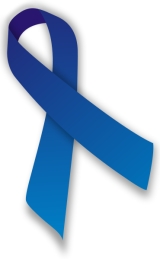 |
| In 2008, the CDC also said the annual cost of dealing with abuse in the U.S. is an astonishing $124 billion! In addition, they calculate the lifetime costs for all the issues surrounding each one year's worth of abused kids at an incredible $585 billion!! And this figure repeats EVERY YEAR !!! Each day in April, NAASCA will feature another unique offering to the community (one a day, 30 in all) encouraging those willing to speak out about child abuse. Our theme for 2014 is: Child Abuse lives everywhere, in every community -- don't be afraid to talk about it. We hope the posters, associated essays and links we've offered will get the conversation going! Bill Murray NAASCA CLICK HERE: learn more about our BLUE RIBBON NEIGHBORHOOD WATCH Campaign |
|
| Child Abuse lives everywhere -- don't be afraid to talk about it | ||
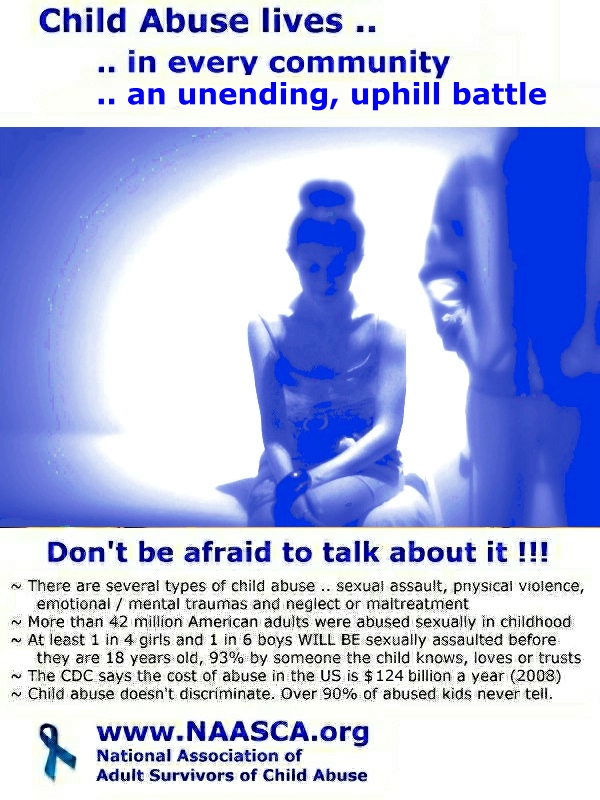 |
Child Abuse lives .. ...... in every community ...... an unending, uphill battle The battle against Child abuse and trauma goes on, and on, and on. Here's a bit from the Executive Summary, Department of Justice's Report to Congress in July 2010: The sexual abuse and exploitation of children rob the victims of their childhood, irrevocably interfering with their emotional and psychological development. Ensuring that all children come of age without being disturbed by sexual trauma or exploitation is more than a criminal justice issue, it is a societal issue. Despite efforts to date, the threat of child sexual exploitation remains very real, whether it takes place in the home, on the street, over the Internet, or in a foreign land. Because the sexual abuse and exploitation of children strikes at the very foundation of our society, it will take our entire society to combat this affront to the public welfare. Therefore, this National Strategy lays out a comprehensive response to protect the right of children to be free from sexual abuse and to protect society from the cost imposed by this crime. In the broadest terms, the goal of this National Strategy is to prevent child sexual exploitation from occurring in the first place, in order to protect every child’s opportunity and right to have a childhood that is free from sexual abuse, trauma, and exploitation so that they can become the adults they were meant to be. This Strategy will accomplish that goal by efficiently leveraging assets across the federal government in a coordinated manner. All entities with a stake in the fight against child exploitation — from federal agencies and investigators and prosecutors, to social service providers, educators, medical professionals, academics, non-governmental organizations, and members of industry, as well as parents, caregivers, and the threatened children themselves — are called upon to do their part to prevent these crimes, care for the victims, and rehabilitate the offenders. Little has changed, much is still to be done. Please see: http://www.naasca.org/2012-Articles/121212-DOJ-ChildhoodViolence.htm |
|
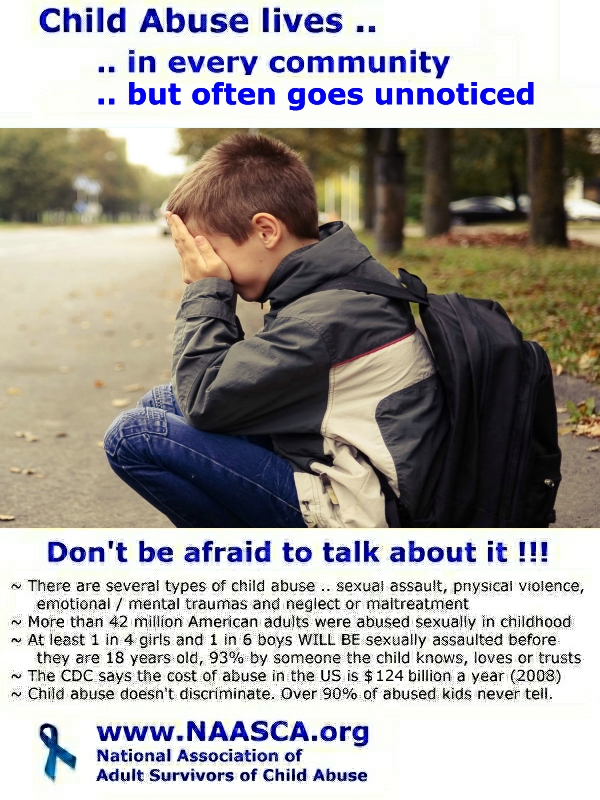 |
Child Abuse lives .. ...... in every community ...... but often goes unnoticed Recognizing child abuse and trauma isn't always easy, but it's an adult responsibility. Kids do not self-report. Many times there are few obvious physical marks on a child, so the first step is to learn what to be aware of. The most typical things to watch for are changes in behavior, attitudes and performance, and these can be a little different for very young kids and those who are a bit older. Her's a list of some symptoms of sexual abuse and trauma in children that don't include obvious physical signs. Indicators of sexual abuse in young children include: » Sleep disturbances » Bed wetting and/or loss of fecal control » Regressive behavior » Self-destructive or risk-taking behavior » Impulsivity, distractibility, difficulty concentrating » Refusal to be left alone » Fear of an individual, such as an alleged offender » Fear of people of a specific type or gender » Fire setting » Cruelty to animals » Problems relating to peers » Sudden changes in behavior » Difficulties in school » Inappropriate interest (for the age) in things sexual Indicators of sexual abuse in older children include: » Eating disturbances (overeating, bulimia and anorexia) » Running away » Substance abuse » Self-destructive behavior, suicide attempts, self-mutilation » Incorrigibility » Criminal activity » Depression and social withdrawal » Problems relating to peers » Sudden changes in behavior » Anger issues » Difficulties in school Please see: www.SpeakingOut-CSA.com/SignsSymptoms.html |
|
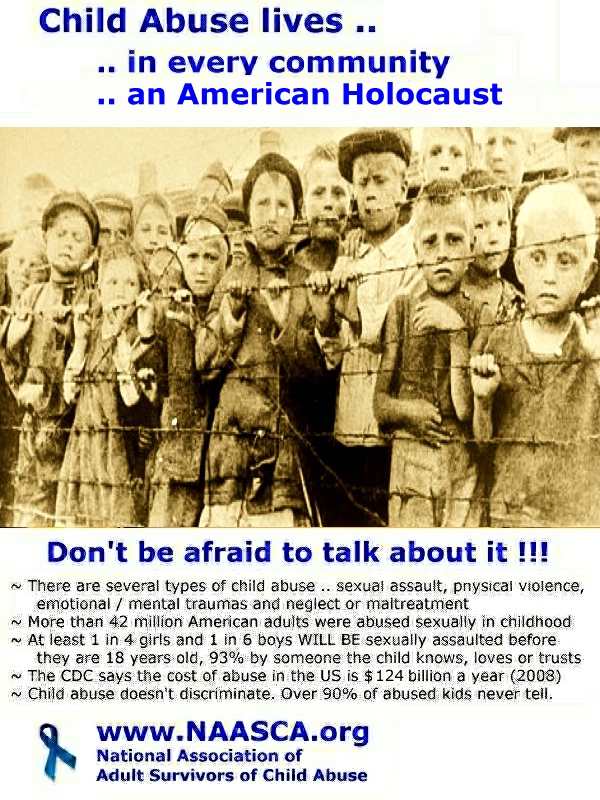 |
Child Abuse lives .. ...... in every community ...... an American Holocaust An air raid siren signaled a two minute moment of silence in Israel today, in honor of the 6 million Jewish Holocaust victims who died in concentration camps in World War II. The annual Day of Remembrance is a an opportunity to acknowledge the suffering of all the survivors, too. Too bad we don't pause in our country, even for a moment, to consider the pain of the over 42 million American adult survivors of child abuse. They, too, were innocent victims of a much stronger predator group, from whom there was no resistance. We have our own ongoing American Holocaust with millions of child-victims suffering at the hands of a group of criminals who think nothing of taking advantage of America's kids. Are we staying silent? Are we turning away? Are we in denial that these aren't "our issues" .. that they don't effect us? Officially (and conservatively speaking) 1 in 4 girls and 1 in 6 boys WILL BE sexually assaulted before they are 18 years old. That's 20% of our population alone, and does not include all those who will be abused with physical violence, emotional and mental traumas and neglect or maltreatment. As we approach the end of the 32nd National Child Abuse Awareness month are we secretly relieved that it'll be another year before we need be concerned with being the voice for the victims and survivors, millions strong? Or can we come to our senses, recognizing the magnitude of the tragedy that's happening all around us, and right under our noses? Can we .. WILL we .. redouble our efforts to turn the tide of unthinking denial of the rights and need for protection of America's children .. our most precious resource? Join us .. speak out .. be the voice for the children who have no voice. Please see: http://www.NAASCA.org/Video/ |
|
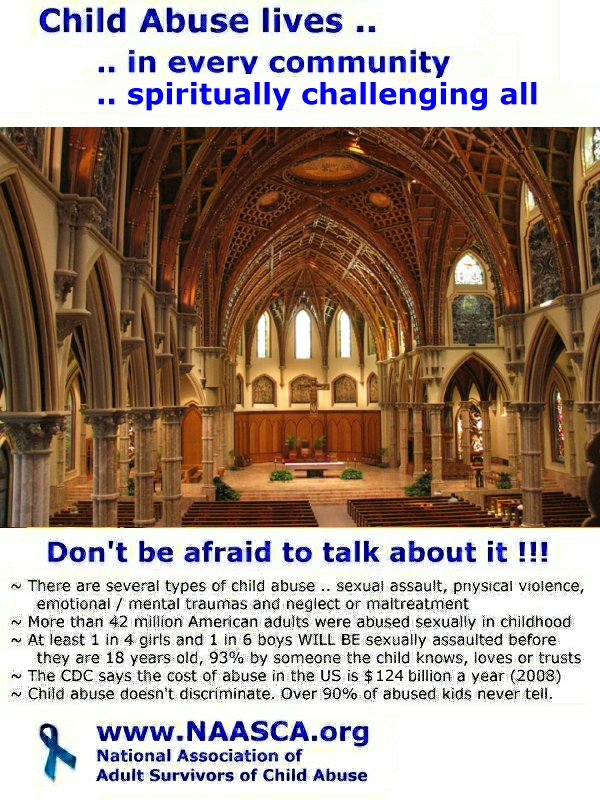 |
Child Abuse lives .. ...... in every community ...... spiritually challenging all Some thoughts: Innocent & guilt free, we share feelings of shame & fear We should accept no responsibility for our abuse in childhood Our low self-esteem and feelings of worthlessness are lies Our lives changed forever, the moment we were first violated We were diverted from our destiny Our scars can become a permanent part of who we are We suffer a kind of insanity often involving deep depression The resentments we carry are controlling us, defining us We are not alone We are as sick as our secrets Recovery is possible, if we work for it We can have a complete change in our character We can have a new altitude on life .. feel useful We can serve the world by helping rid it of child abuse Its better to recover together than to survive alone About Recovery A primary mission at the National Association of Adult Survivors of Child Abuse is to help abused people who have reached maturity get into recovery. We've been there, and our membership includes people who have recovered in a number of ways, many of us using one or more of the many resources we recommend on our site. Please see: www.NAASCA.org/Groups-Services/_Groups-Services.htm |
|
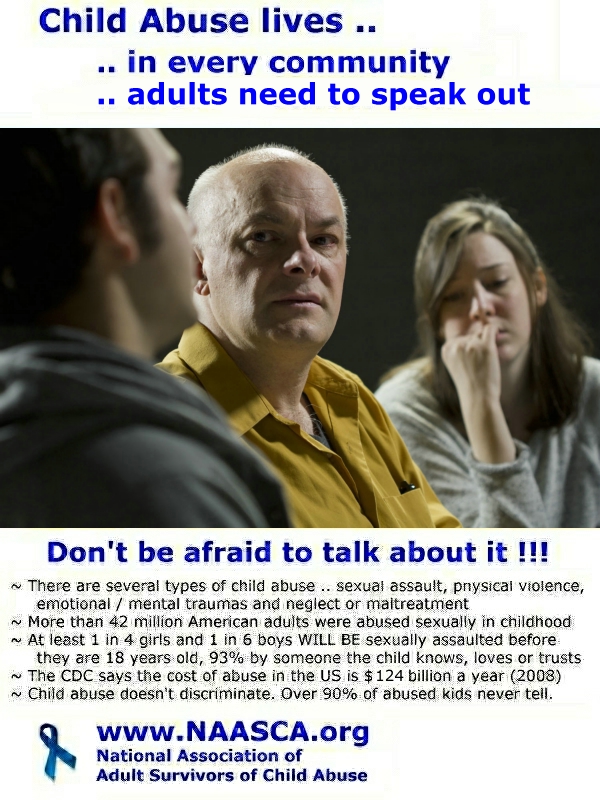 |
Child Abuse lives .. ...... in every community ...... adults need to speak out Do More Than Just Survive - “Imagine if every adult who has ever been molested as a child recognized they were not alone. Imagine if every adult who has ever been molested as a child let go of a shame that was never theirs to carry. Imagine if every adult who has ever been molested as a child found their voice. Imagine if every adult who has ever been molested as a child joined hands and told their story. Our country needs us to speak the truth, because we have a nation of adults doubting if there is really a problem or that there even is an epidemic. This journey of honesty is not only to help heal ourselves but to protect this generation of children and the next generation and the next. Sexual abuse of children can be stopped. It needs a voice. Our voice.” -- Randa Fox, NOOW / Not On Our Watch (CoFounder) notonourwatch.net Reveal the Truth - Uncover the crime committed against you when you were a child. Don't keep it a secret any longer. There's no shame in it for you, regardless of how it may feel. You were a child, an innocent victim. But that doesn't mean that you have to remain a victim for the rest of your life. Talk About It - There is healing in being able to talk about the violation you endured as a child. Find that person or group that you feel safe with & trust to discuss your abuse openly. The purpose is to face what happened & move forward. Because of the sensitivity of this topic, if you fail to find that right person or group at first, try again. There are people out there that are willing to listen. You are not alone. Seek Professional Help (If Needed/As Needed) - Support Group, Therapist, etc, you can research to find the right avenue for you. For example, you may want to talk to your local Pastor about resources in your area. Do Something About It - Get involved in the fight against child sexual abuse, whatever that means for you. Fight hard against the very thing that "tried" to destroy you. Help break the cycle of this horrible crime. Save a child! Please see: www.SpeakingOut-CSA.com |
|
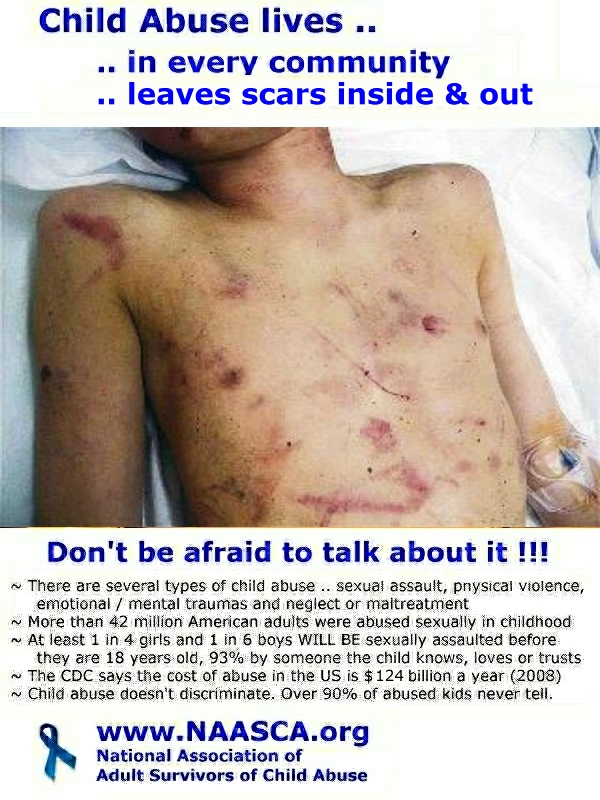 |
Child Abuse lives .. ...... in every community ...... leaves scars inside & out Child abuse comes in several forms including sexual assaults, violent or physical abuse, emotional and mental traumas and neglect (also known as maltreatment). Each type of abuse leaves a set of scars, some on the outside, but most of them hidden. Between 4 and 5 kids die each day in our country, most of them infants and toddlers who can not defend themselves from the adults around them. Many more children carry bruises, welts and contusions, obvious signs of physical trauma. But the worse effects of child abuse are unseen .. invisible and frequently lifelong. People say we should "get over it." This is the experience of by far the largest group of adult survivors of child abuse. We struggle to recover. As NAASCA family member David Pittman, founder of "Together We Heal," says in a recent article, "Many of us, including myself, wonder when things will “get better.” In group this week we even talked about how we didn't understand why, after going through so much therapy why we would still have the past come back and bite us in the butt. We even have members of our family or friends say, why don't you just get over it? The thing is, we never “get over” what we have been through. The best we can hope for is to “work through it” and to heal. And so together, helping one another with what has helped each of us, we try to do just that." And later .. " As I was writing this I thought of something to say the next time I hear those words…I'll ask them, would you tell me to “get over it” if I had cancer or heart disease? Of course not because that would be ridiculous. Well, what we are going through is like a cancer of our minds and disease of our hearts. If we don't address it in a healthy way it tears us apart from the inside out." 42 million American adults are survivors of childhood sexual abuse, and most of them, and their scars, remain hidden. Please see: http://sol-reform.com/News/get-david-pittman/ |
|
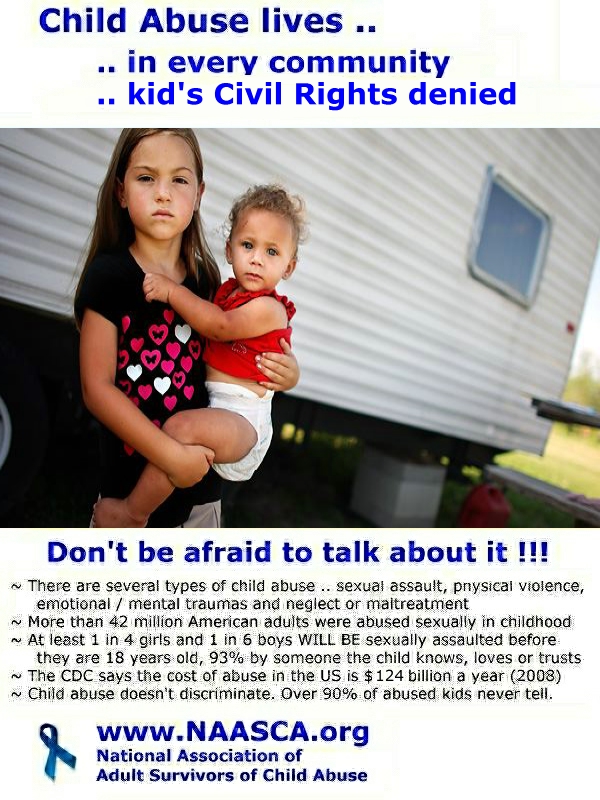 |
Child Abuse lives .. ...... in every community ...... kid's Civil Rights denied The one remaining and almost completely hidden issue of equality and Civil Rights are those of children. Every citizen in America is guaranteed the right to enjoy the same Constitutionally protections .. and the rights to life liberty and the pursuit of happiness. We measure the success of the American Dream against the equal distribution of these guarantees, and over the years we've seen sometimes desperate long-term struggles to ensure them. The Civil War was fought in the 1860s largely to decide whether States' Rights could supercede Constitutional Rights, opening the door to the Civil Rights Movement for people of color a century later. Less than 100 years ago women won the right to vote, leading to the more recent Woman's Rights Movement. Today there is a well-established and ongoing fight for the rights of the LBGT community. Few believe we'll ever go back to a time when the Civil Rights of these groups will be completely denied. In each case it was the raised voice of the group of people suffering inequality that eventually caused the rest of the country to pay heed. But children have no voice. Adults must speak FOR them. As a group of citizens they, too, deserve the same rights, services and protection of the Federal Government as every other group, rights that should not be denied solely on the basis of their youth. We are discriminating against children simply because of their age, treating them unequally and holding against them the fact that they don't complain. Until we recognize these citizens deserve the Constitutional Civil Rights of any other group we'll not see this as a National priority, and won't rally all the resources we need to protect and serve them. It'll stay a local issue. Let's not doom yet another generation of kids to the pain and suffering of child abuse, trauma and neglect. Please see: www.ChildrensRights.org |
|
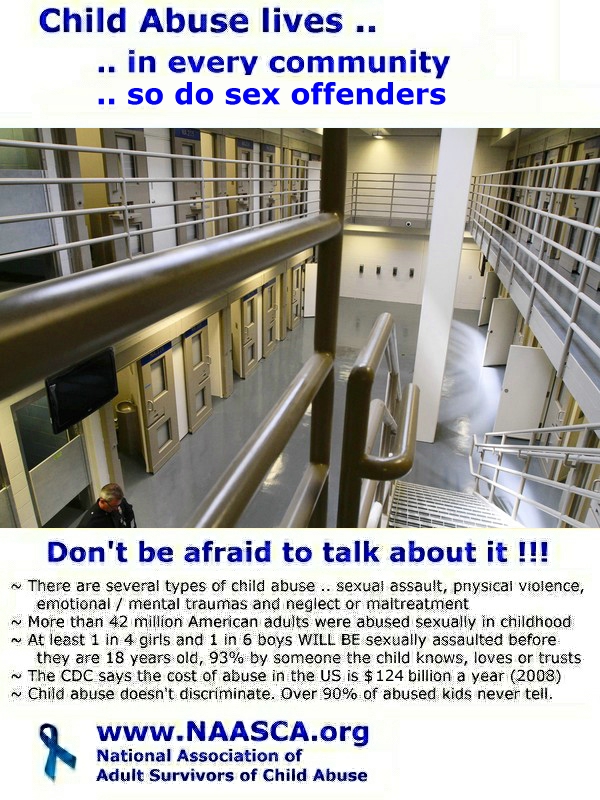 |
Child Abuse lives .. ...... in every community ...... so do sex offenders The number of registered sex offenders of children in the United States is measured in the hundreds of thousands. They, like their victims, reside in every community. |
|
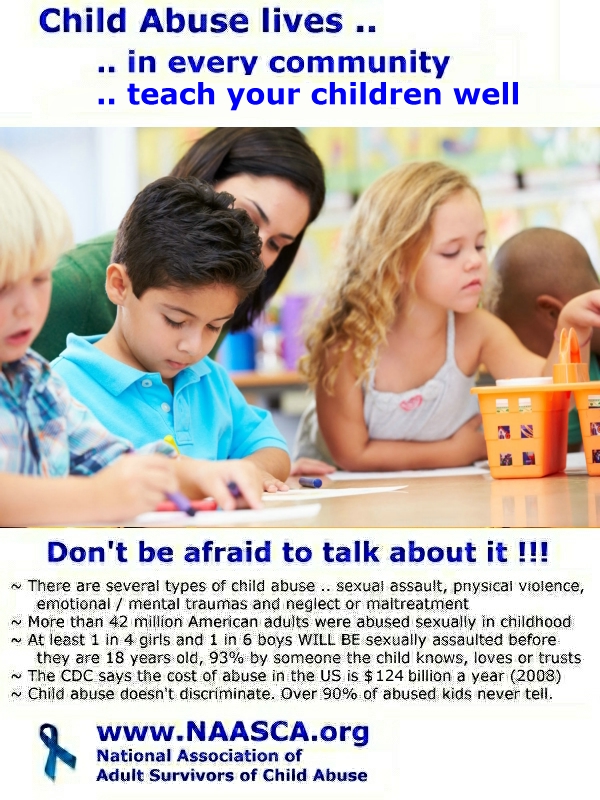 |
Child Abuse lives .. ...... in every community ...... teach your children well Children must be taught about Prevention from the earliest age. They should learn the correct anatomical names for their body parts, that they have a right to body privacy, that there's a difference between "secrets" and keeping a surprise. They should be taught, at age appropriate stages, about bringing any uncomfortable feelings of any boundary violations to a trusted adult .. and if they are not happy with the response they get they should be taught to keep telling other adults until they get help that makes them conformable again. NAASCA Resources www.NAASCA.org/010111-Resources.htm |
|
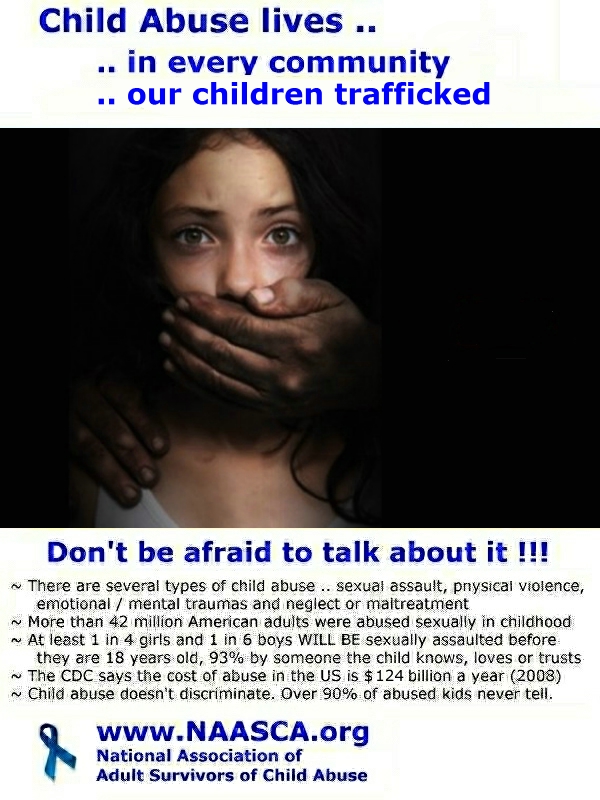 |
Child Abuse lives .. ...... in every community ...... our children trafficked Human trafficking victims have been identified in cities, suburbs, and rural areas in all 50 states and in Washington, D.C. Recent estimates suggest
human trafficking is a $32 billion a year enterprise worldwide, second only to drug smuggling.
The Center for Missing and Exploited Children estimates some 100,000 victims a year are turned out as child prostitutes, and the average age for these kids is 13 years old. They are forced to provide commercial sex against their will. |
|
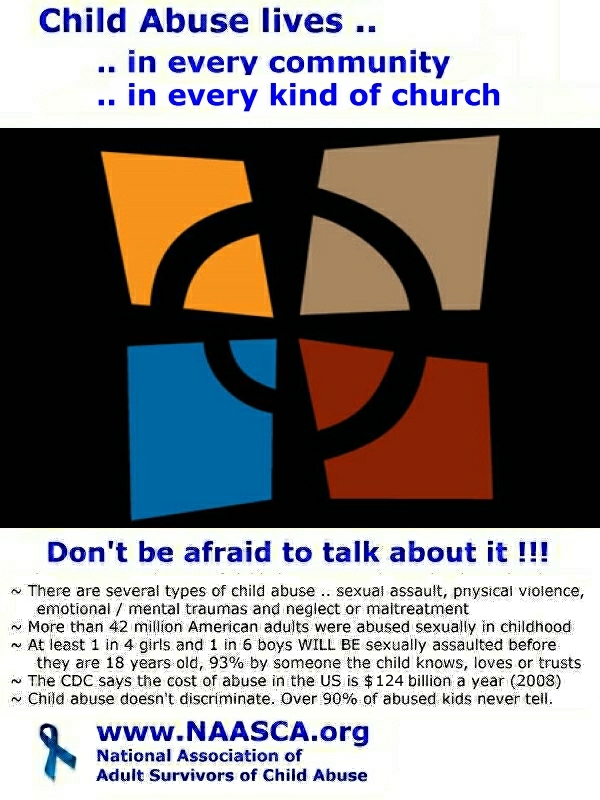 |
Child Abuse lives .. ...... in every community ...... in every kind of church The Church's role in the community war against the evil of abuse is to learn what we can, deal with the problem as it exists, and share our experiences with others who are equally motivated. Society is uniting, rising up and rooting out child abuse. Over and over again, we see entire communities mobilize to search for children feared kidnapped and abused. It is national news when a single child is in danger. But child abuse was not always the subject of national media reports. This evil lurked in the shadows, mostly unseen, almost always unmentionable. Yet even before the issue first came to the forefront in the United States, Gordon B. Hinckley, former president of The Church of Jesus Christ of Latter-day Saints, publicly denounced child abuse as a terrible evil. In the early 1980s, he captured our thoughts and feelings when he said in a worldwide conference broadcast: "I am glad that there is a growing public awareness of this insidious evil. The exploitation of children . . . for the satisfaction of sadistic desires is sin of the darkest hue." What other position could the Church possibly take?What other position, indeed. Christian, Jew, Hindu or Muslim, all religious groups recognize the need to nurture innocent children, our lambs, and to fight the evil of child abuse no matter where it's rooted out. Please see: www.MormonNewsroom.org/official-statement/child-abuse |
|
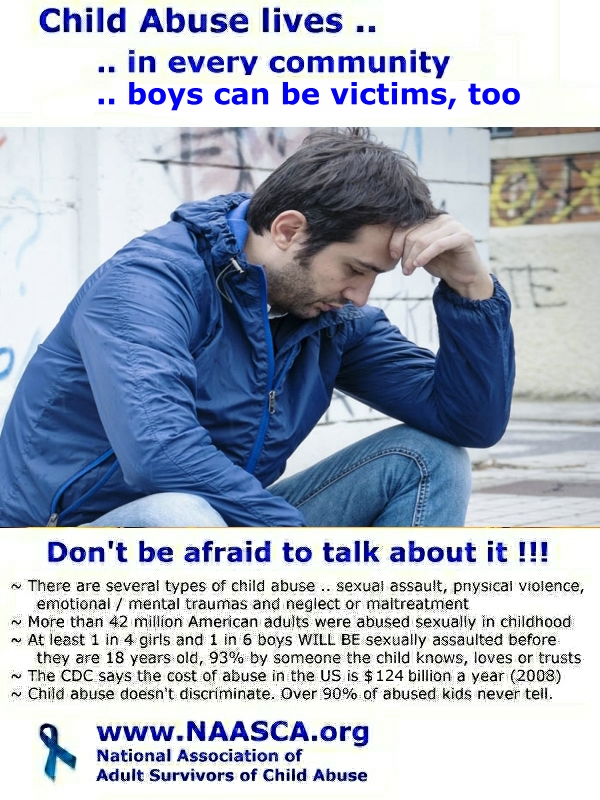 |
Child Abuse lives .. ...... in every community ...... boys can be victims, too The following list of Myths & Facts is adapted from a presentation at the 5th International Conference on Incest and Related Problems, Biel, Switzerland, August 14, 1991. Myth #1 - Boys and men can't be victims. Myth #2 - Most sexual abuse of boys is perpetrated by homosexual males. Myth #3 - If a boy experiences sexual arousal or orgasm from abuse, this means he was a willing participant or enjoyed it. Myth #4 - Boys are less traumatized by the abuse experience than girls. Myth #5 - Boys abused by males are or will become homosexual. Myth #6 - The "Vampire Syndrome" - that is, boys who are sexually abused, like the victims of Count Dracula, go on to "bite" or sexually abuse others. Myth #7 - If the perpetrator is female, the boy or adolescent should consider himself fortunate to have been initiated into heterosexual activity. Believing these myths is dangerous and damaging. So long as sexually abused males believe these myths they reinforce the power of another devastating myth that all abused children struggle with: that it was their fault. Please see: |
|
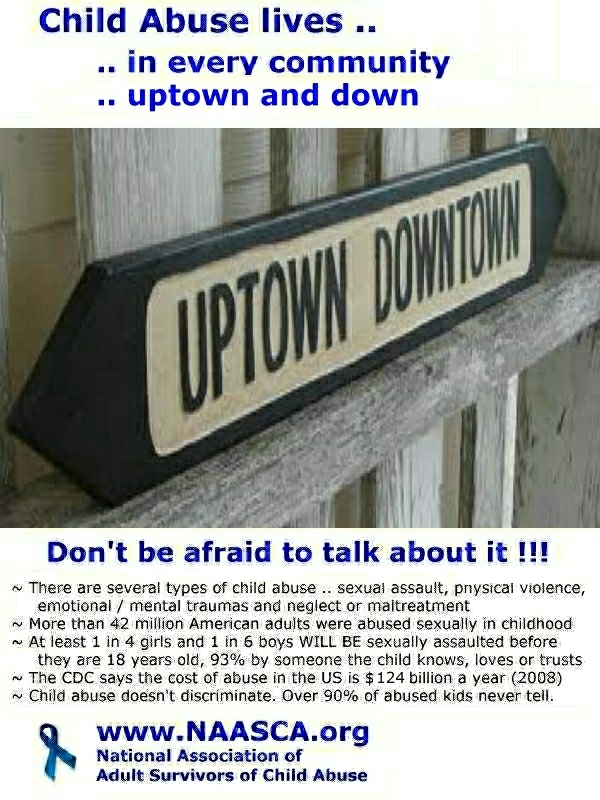 |
Child Abuse lives .. ...... in every community ...... uptown and down If you are not exactly sure what sexual abuse is, you're not alone. All sexual touching between an adult and a child is sexual abuse. Sexual touching between children can also be sexual abuse when there is a significant age difference (often defined as 3 or more years) between the children or if the children are very different developmentally or size-wise. Sexual abuse does not have to involve penetration, force, pain, or even touching. If an adult engages in any sexual behavior (looking, showing, or touching) with a child to meet the adult's sexual needs or interest, it is sexual abuse. Most often child sexual abuse is a gradual process and not a single event. By learning the early warning signs and how to effectively step in and speak up, sexual abuse can be stopped before a child is harmed. Adults must take the primary responsibility for preventing child sexual abuse by addressing any concerning or questionable behavior which may pose a risk to a child's safety. Some people who abuse children have adult sexual relationships and are not solely, or even mainly, sexually interested in children. More than a third of those who engage in sexual activity with children are under the age of 18 themselves. In many of these instances, the abusive child may not understand that his or her sexual actions toward another child are harmful. It's important to remember that many terms used to describe people who sexually abuse children, like "pedophile" or "sexual predators," are often misused according to their clinical or legal definition. And, media stereotypes of "child predators" and "monsters" may actually make it more difficult for us to recognize or acknowledge inappropriate behaviors in those people we know. Please see: Stop It Now! |
|
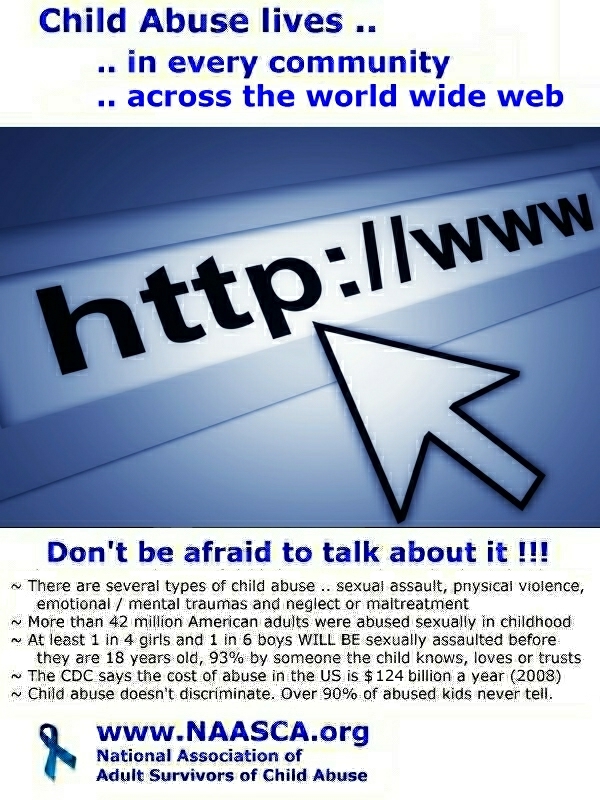 |
Child Abuse lives .. ...... in every community ...... across the world wide web The FBI offers a "Safe Online Surfing" program in schools. Recent studies show that one in seven youngsters has experienced unwanted sexual solicitations online. One in three has been exposed to unwanted sexual material online. One in 11 has been harassed or bullied online. And as we all know, these are only some of the dangers that our kids face while surfing the Internet. How can we simultaneously protect them from these threats and enable them to take advantage of the positive things the web has to offer? In addition to investigating online crimes targeting children, the FBI works to educate kids and their parents about the Internet, sometimes sending cyber agents to visit schools as well as posting useful resources on their public website. They also offer the "Safe Online Surfing" program to schools to help students understand how to recognize, report, and avoid online dangers. |
|
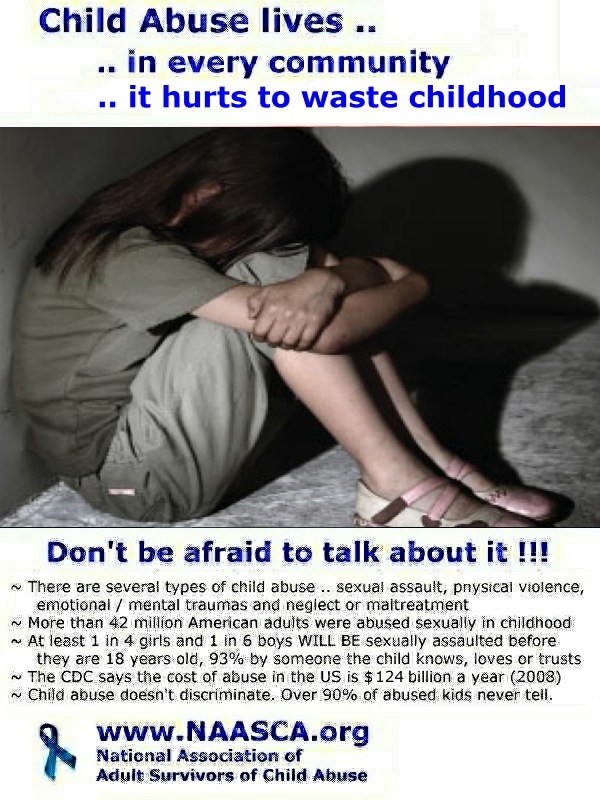 |
Child Abuse lives .. ...... in every community ...... it hurts to waste childhood End of the Innocence - Don Henley, Bruce Hornsby - Remember when the days were long And rolled beneath a deep blue sky Didn't have a care in the world With mommy and daddy standin' by But "happily ever after" fails And we've been poisoned by these fairy tales ... ....But I know a place where we can go And wash away this sin We'll sit and watch the clouds toll by And the tall grass wave in the wind... ...Offer up your best defense But this is the end This is the end of the innocence ... ~~~~~~~~~~~ Oh how do these words ring true for so many children who have had their innocence stolen from them due to sexual abuse. A study from the US Dept of Health reported that hundreds of thousands of children are victims of sexual abuse per year. The problem is that so many, the majority, go unreported. Sexual abuse in girls is a staggering 25%; 1 out of every 4 young girls is a victim. ONE OUT OF 4!! Psychological harm "Child sexual abuse can result in both short-term and long-term harm, including psychopathology in later life. Psychological, emotional, physical, and social effects include depression, post-traumatic stress disorder, anxiety, eating disorders, poor self-esteem, dissociative and anxiety disorders; general psychological distress and disorders such as somatization, neurosis, chronic pain, sexualized behavior, school/learning problems; and behavior problems including substance abuse, self-destructive behavior, animal cruelty, crime in adulthood and suicide." Please see: End Of The Innocence |
|
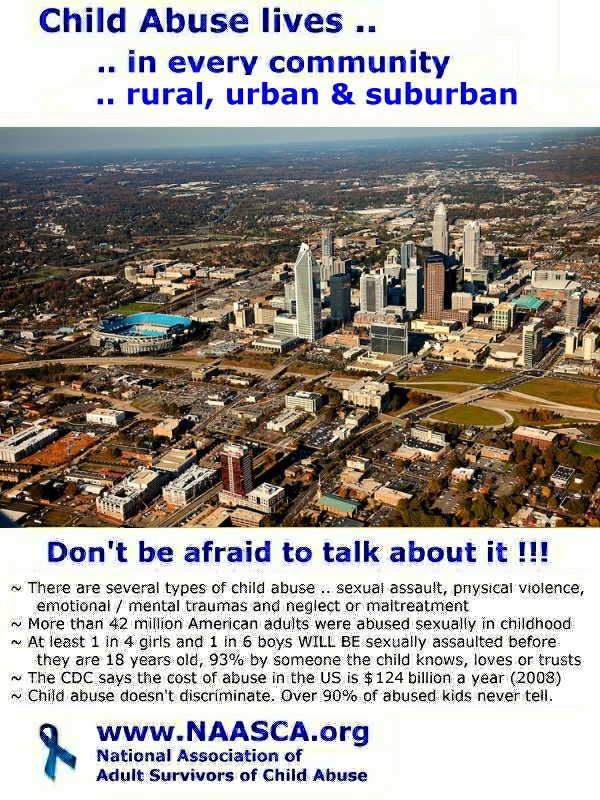 |
Child Abuse lives .. ...... in every community ...... rural, urban and suburban 2012 NATIONAL ABUSE STATISTICS
Please see: U.S. Department of Health and Human Services, http://www.acf.hhs.gov/sites/default/files/cb/cm2012.pdf, and National Statistics 2012 and 2013 Children's Advocacy Centers, http://www.nationalchildrensalliance.org/file.php/5208/NCA-NationalStatSheet-2013TotalStatistics.pdf |
|
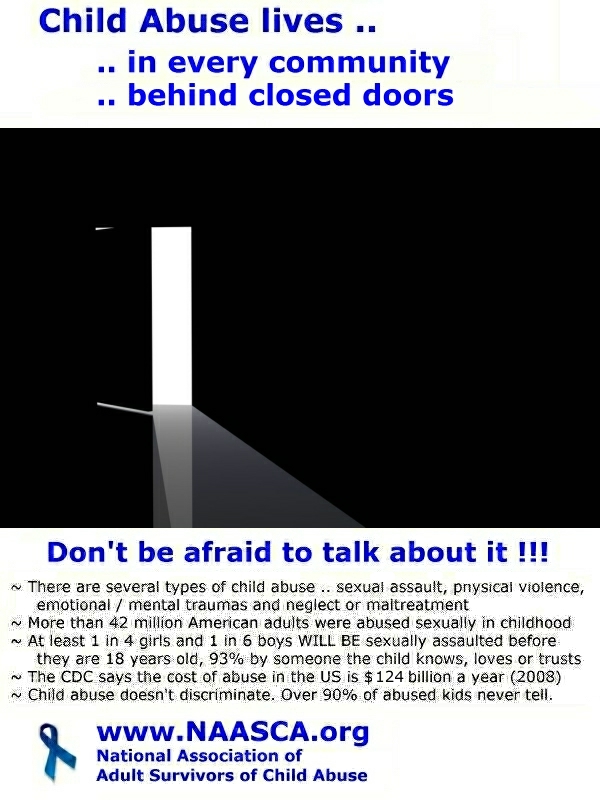 |
Child Abuse lives .. ...... in every community ...... behind closed doors Some research suggests as few as 1 in 10 cases of child abuse is during youth. But this means 90% suffer through childhood in silence .. behind closed doors. Tithe vast majority become adults heavily burdened by the weight of their secret traumas. Most will determine its best to deal with things by themselves .. behind closed doors. The persistence of this thinking is astonishing. Virtually every decision, every choice and every relationship is effected, decade after decade, and many take their story to death. Child abuse is considered a frightening taboo topic, "someone else's problem." People in denial say it WON'T effect them, as long as its kept where it belongs .. behind closed doors. A few lucky adult survivors of child abuse will turn to recovery at some point. We recommend newcomers to healing stay anonymous a bit longer .. to all but their therapists, coaches, fellow recovery group members, etc .. until they're strong enough to risk public knowledge of their youthful abuse and trauma. And then, when comfortable with their recovery, we need survivors to open their previously closed doors, a little at first, just a crack, speaking from personal experience. We ask such folk to come out of the closet of their abuse. After all, abused kids have no voice, society members and still secretive adult survivors won't discuss these issues, and newcomers to recovery are still too vulnerable to speak out. No other people are better positioned than those on their healing journey who are now comfortable in recovery to break down these taboos and convince the public that this should be an issue of the highest National priority. Bring the topic out from behind closed doors. Come out of the closet. Please see: Breaking the Silence for Child Abuse Victims |
|
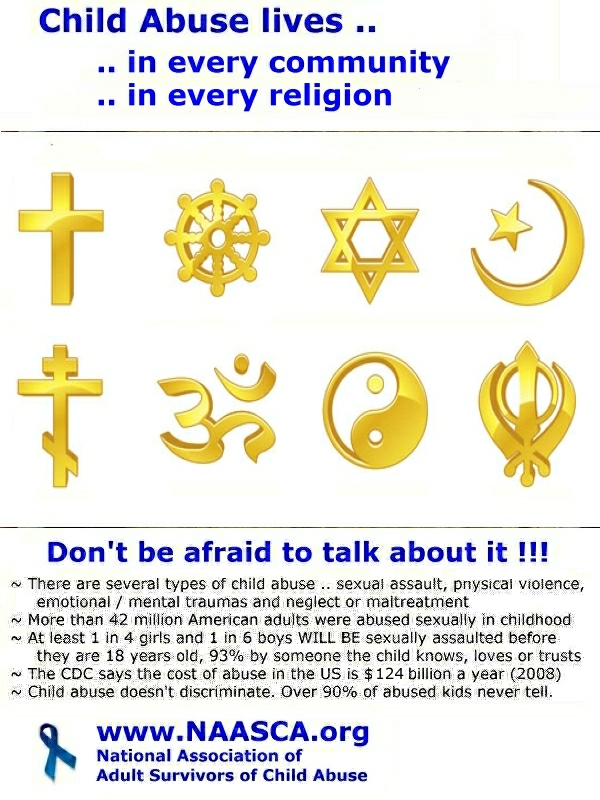 |
Child Abuse lives .. ...... in every community ...... in every religion Most people are aware of the scandals that have been exposed in the Catholic Church regarding priests and brothers sexually abusing children. Adding insult to injury, as they discovered offenders many church leaders chose to shuffle them from parish to unsuspecting parish, rather than report the criminal abuse to authorities. Rarely has the welfare of abused children been a focus. Just this week the Pope publicly apologized for the actions of the Church's priest predators, and acknowledged the cover-ups. But we also know that the problem exists world-wide in virtually all religious groups .. in churches, mosques, ministries, temples and cults (and many other community groups) .. cleverly hidden in each organization. One country, Australia, is in the middle of what could be among the most revealing studies of institutionalized child abuse ever done. Launched in 2013, The Royal Commission into Institutional Responses to Child Abuse will produce an Interim report no later than June 30, 2014. The final reporting is expected at the end of 2015. The Royal Commission has been holding public hearings into past and present cases involving a range of institutions so that they can make findings and recommendations. Thus far the Commission has taken testimony from a number of interested parties .. ranging from the Catholic Church to the Salvation Army .. and will be reviewing other churches, schools, sports clubs, childcare centers and foster care. The Royal Commission will attempt to identify what it is that institutions, government and the community can do to better protect children from sexual abuse. Individuals from across Australia who were sexually abused in an institution when they were a child can tell their story directly to the Royal Commission. This approach is so refreshing as to offer hope that other countries will follow suit. Please see: Australian Child Abuse Royal Commission http://www.childabuseroyalcommission.gov.au/ |
|
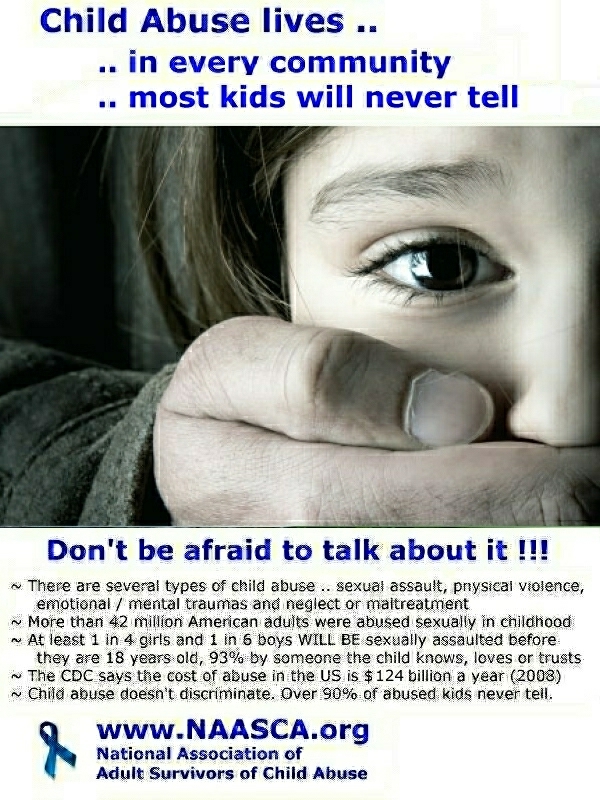 |
Child Abuse lives .. ...... in every community ...... most kids will never tell Some studies say an estimated 850,000 new cases of childhood sexual assault occur each year. Others refute this figure, noting reports of child abuse are among the least likely criminal reports made. Then, too, these numbers for sexual abuse and don't include trauma that's caused by physical violence that has no sexual element, severe emotional or mental traumas that can be devastating in later life, or neglect (the largest category). Sadly the vast majority of kids are, for a number of reasons, unlikely to speak up about their abuse. One study said as many as 9 out of 10 children turn 18 without telling. These children emerge into adulthood with the secret case of their untreated trauma as the weighty burden of their young lives. So .. why don't kids tell .. ? From a child's perspective their experiences may seem inescapable. Others are told by their predator that revealing the secret will have serious consequences. Kids are threatened by the death of a sibling, a pet or a parent, and are told no one will believe them anyway. Children are told they are to blame and take on a sense of responsibility and shame that extends well into adult life. They figure they could somehow have avoided the predator. Many have a sense of being broken, and fear being discovered by a judgmental society. The truth is that children are NEVER to blame for these things. It's always the adult who bears all the responsibility, and their acts are always criminal. 42 million American adults suffered childhood sexual abuse. Our society must do all we can to reduce the incidence of child abuse to today's at-risk group of kids. And we must offer as many healing opportunities as we can to the adult survivors of child abuse who are still keeping their secrets. Please see: Reactions of Adult Survivors of Childhood Sexual Assault - article from RAINN |
|
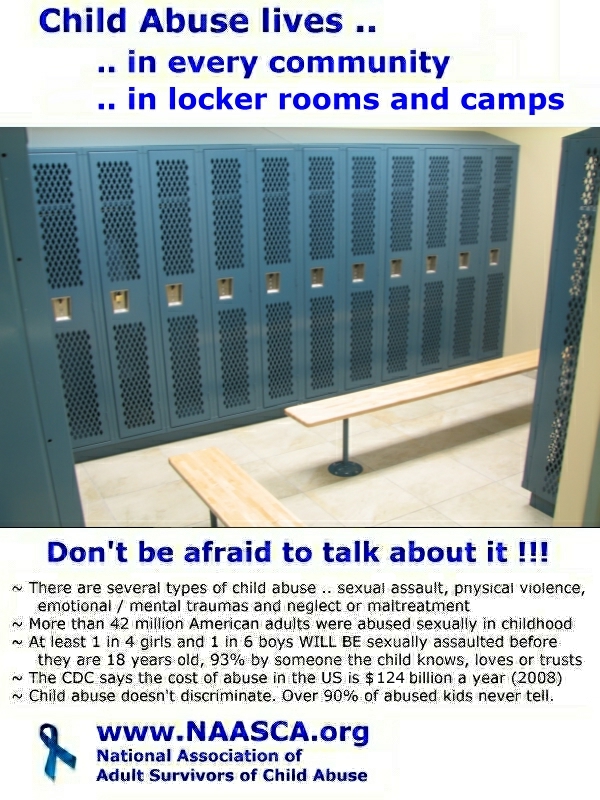 |
Child Abuse lives .. ...... in every community ...... in locker rooms and camps Only 7% of the kids who are sexually assaulted in America are accosted by complete strangers. 93% are abused by people the child knows, loves or trusts. Two thirds of this group are preyed upon by family members. The remaining third suffer at the hands of folks who the child is taught to respect and trust, and many fall into the category we'd likely call "caregivers." Babysitters, teachers, ministers, and charity (volunteer) workers are examples of this .. as are coaches and camp councilors. Recent stories about Penn State's football team abuses and those perpetrated for years by the Boy Scouts are but highlights of a serious problem .. the tip of the iceberg. The truth is they constitute only a couple of the thousands of such situations going on in every community, and mostly right under our noses. Millions of kids are encouraged every year to participate in sports and athletic or outdoor activities both at the schools they attend and during the summer at camps. Unfortunately, pedophiles select careers or volunteer for things that provide them with a constant stream of potential child-victims. They're very clever at grooming the youngster and the adult community that they are above reproach. The reputations they enjoy make it hard for us to believe they could possibly be molesting children. We frequently have a hard time accepting their guilt. Then, too, the very institutions they represent, whose mission is to train / educate / care for children, have been reluctant to report abuse, even decades after it has been discovered. Thousands and thousands of America's kids are trapped .. Please see: from LA Times: Boy Scouts - Inside the 'perversion files' |
|
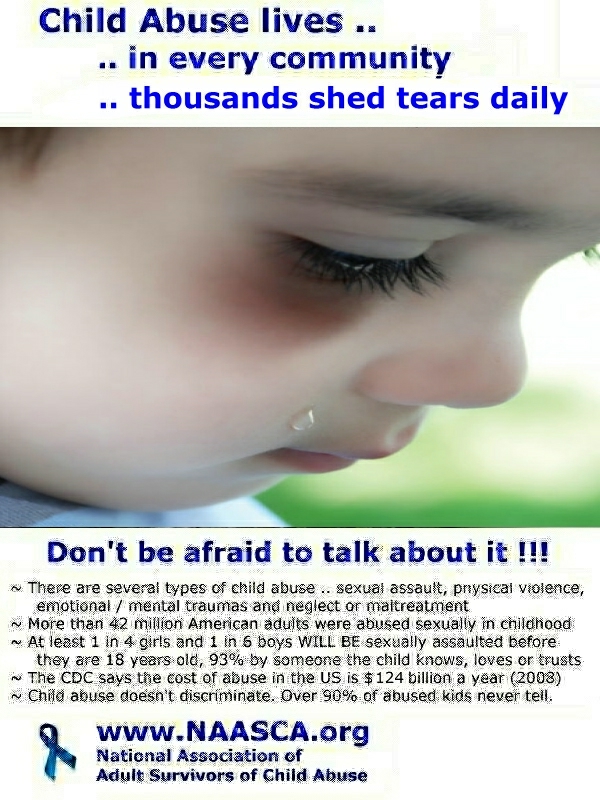 |
Child Abuse lives .. ...... in every community ...... thousands shed tears daily The statistics of child abuse are, simply put, astonishing. We frequently use official numbers from Federal agencies, well respected Universities and non profits with decades of experience by way of educating the public about the hidden epidemic of abuse and neglect our kids are experiencing. It's estimated conservatively that some 20% of the children in the US are abused sexually .. the rate is 1 in 4 girls and 1 in 6 boys. Still others are physically or violently abused where there's no sexual element. Others suffer from mental or emotional traumas and still more from neglect (also called maltreatment). As a result, close to half our kids are being traumatized. Here are the "General Statistics" from ChildHelp, celebrating 55 years' of service (which also runs a National Child Abuse HOTLINE):
www.ChildHelp.org/statistics National Child Abuse HOTLINE: 1-800-4-A-CHILD |
|
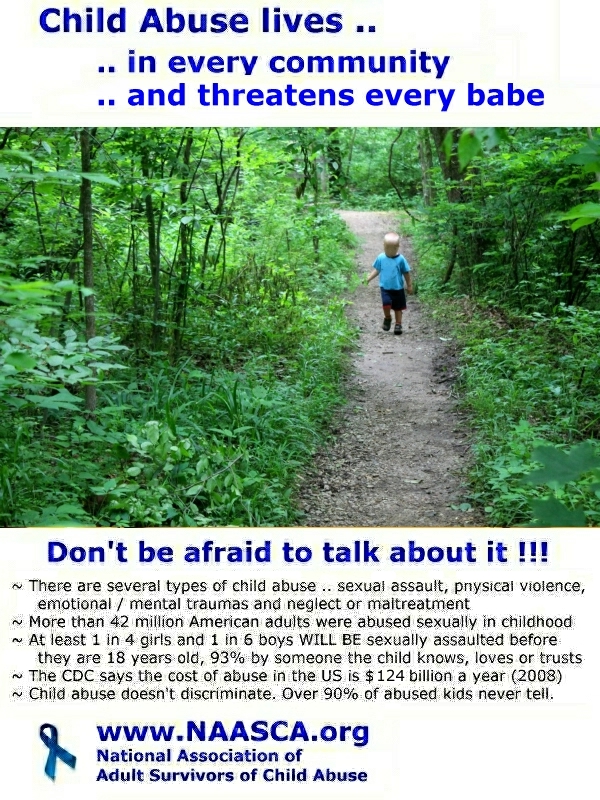 |
Child Abuse lives .. ...... in every community ...... and threatens every babe The trauma experienced as a result of the sexual assault and physical abuse of children causes changes in brain development that are so significant that they last a lifetime. Abused children grow up to be adults who are prone to depression, anxiety, substance abuse and other psychiatric disorders. They are more prone to suicide. However, in recent years we have learned that abuse does more than wound self-esteem and break the spirit. It damages the very substance of the brain and how it functions. In other words, the brain of the abused and traumatized youngster develops in a completely different manner than does that of a normally raised, nurtured child. A major way by which childhood abuse disrupts normal brain activity is by diminishing its capacity to handle stress. Stress is more than the worry and distress we experience when the circumstances of life push us beyond our limits. The body's response to stress is a complex biological mechanism. The emotional upheavals suffered by adults who were abused as children continue to wreak havoc on jobs and schooling. They lead to substance abuse. They devastate marriages. Thus, the innocent victims of child abuse continue to suffer as adults. We as a society must pursue every means to end the social cancer that reaches deep into the brains of children and across generations. |
|
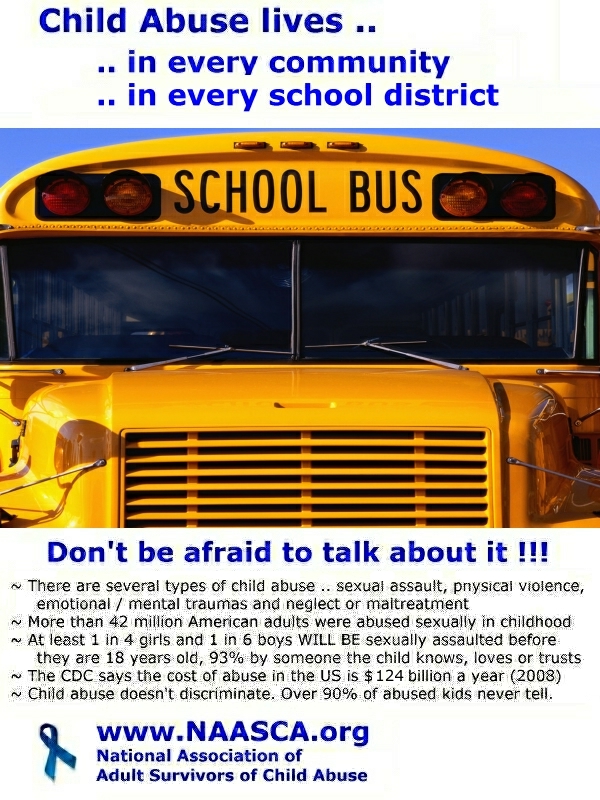 |
Child Abuse lives .. ...... in every community ...... in every school district The children of America are threatened by abuse and trauma in every community across the nation, and an amazing percentage at the hands of a family member. In fact, true stranger danger, where a child has no previous encounters with a predator, account for only 7% of the cases, while fully 93% of the time a youngster is assaulted by someone they know, love or trust. Of this group, about 1/3 are immediate family members .. like mom or dad or a brother .. 1/3 more are "extended" family members .. like a grandfather, mom's boyfriend or a cousin. Many of the last third are in the category we might describe as "caregivers" .. babysitters, teachers, coaches, ministers, volunteers at clubs for kids, etc. Obviously we can not rely on prevention information being reliably provided during their upbringing to the many children in families or other groups that include predators. That's the idea behind a number of efforts that have sprung up to reach the young through schools. One of them is a state by state campaign to require schools systems provide mandated, age appropriate sexual abuse prevention tools to children in grades K through 6. The mission of Erin's law (named after it primary champion, Erin Merryn, a survivor herself) is "to get education in all 50 states on the prevention of sexual abuse by empowering children with their voice instead of allowing sex offenders to silence them." Thus far 8 states have passed a version of Erin's Law, Illinois, Missouri, Indiana, Maine, Michigan, Arkansas, and Mississippi. Many public schools educate children on tornado drills, fire drills, bus drills, stranger danger, and how to say "NO" to drugs. Lets make sure they also include lesson plans on sexual abuse, safe touches, and safe secrets .. empowering kids about the sanctity of their own bodies. Please see: www.ErinMerryn.net/ |
|
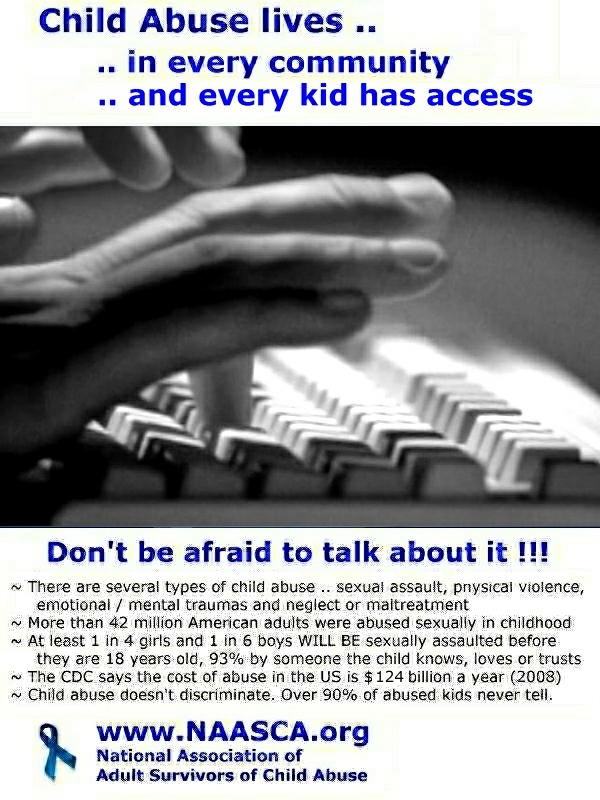 |
Child Abuse lives .. ...... in every community ...... and every kid has access One of the primary gateways to vulnerable children is through the Internet. Smart phones, laptops, iPad type devices and computers of every description are available to kids at home, at school .. basically everywhere. Predators have learned to use the Net with frightening proclivity, enabling them to hide in virtual anonymity and providing them with an unending potential group of victims. Children are often unable to distinguish between seemingly friendly invitations of friendship from peers and those that are offered by cleverly disguised pedophiles. The good news is that the very same technology can be one of your best tools in the fight against child abuse. The CyberTipline, run by the National Center for Missing and Exploited Children, operates in partnership with the FBI, Immigration and Customs Enforcement, US Postal Inspection Service, US Secret Service and other law enforcement. Reports to the CyberTipline are made by the public and by Electronic Service Providers (like American-based web hosting services). Tips are continuously triaged to help ensure children in imminent danger get first priority. The CyberTipline reporting mechanism assists law enforcement and prosecutors in their detection, investigation and prosecution of child sexual exploitation crimes. The CyberTipline helps make law enforcement's efforts more efficient and maximizes the limited resources available in the fight against child sexual exploitation. Combating the abuse, exploitation and trauma of America's kids requires action from the community itself, and it's every adult's responsibility to protect and "serve" every child. The CyberTipline should be recognized as among your most essential tools. Reports can be made over the Internet or by phone. Please see: www.CyberTipline.com 1-800-THE-LOST --- 1-800-843-5678 |
|
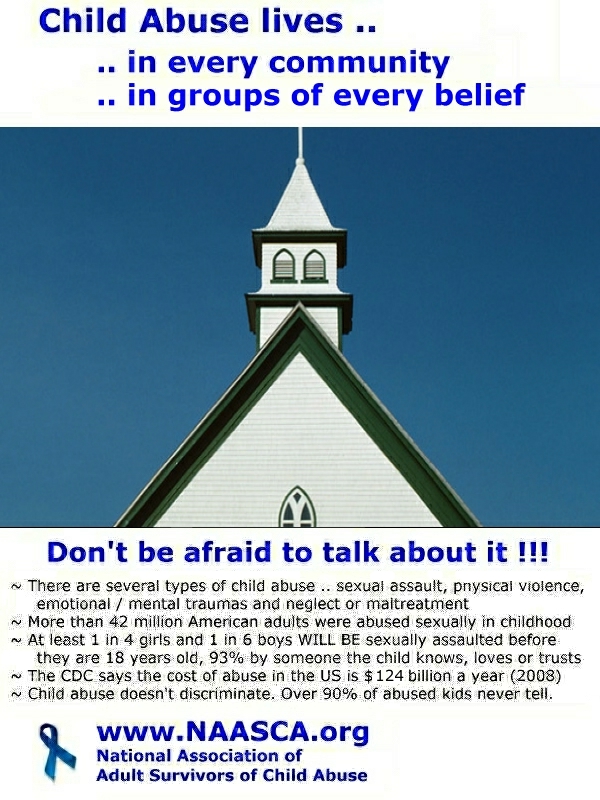 |
Child Abuse lives .. ...... in every community ...... in groups of every belief Child abuse lives in every group and institution where children are gathered .. and this is true world-wide. Late last year the UK's newly formed National Crime Agency released a report verifying children in institutions such as schools, churches, clubs and care homes (like foster care) are not safe from abuse. The NCA warned that child sex offenders often manipulate victims into believing the attention they get is an "honor", making it hard for them to report abuse. In many of the case studies, offenders groomed victims by offering rewards or privilege and the report highlights how, particularly in religious settings, victims and those around them are "often in awe of offenders." Victims in some cases were made to feel indebted to their abusers, making them feel that they were somehow complicit, experts found. The report warned that management structures can discourage junior staff from reporting suspicions, and can also allow offenders to gain the trust of their victims and those who should be protecting them. The report said in some cases, protecting the organization's reputation had taken precedence over reporting abuse, and workers' loyalty to the institution also stopped them from reporting concerns. |
|
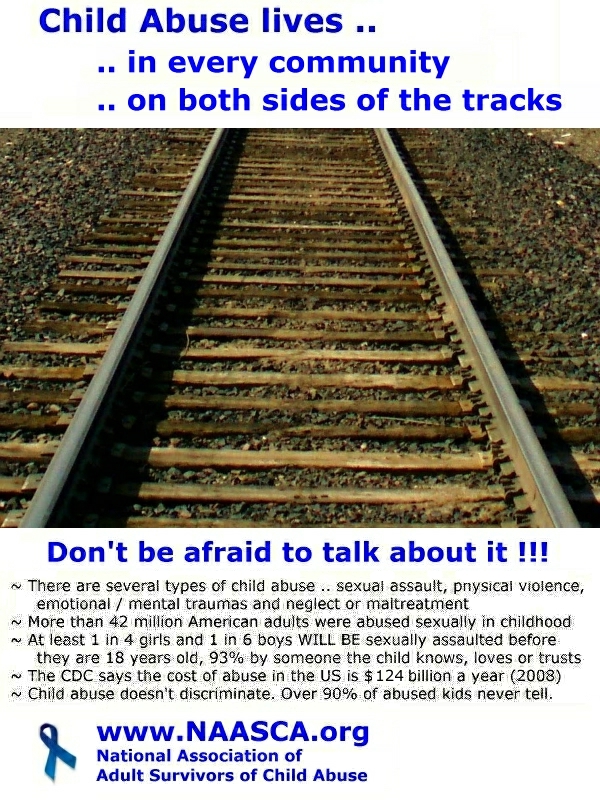 |
Child Abuse lives .. |
|
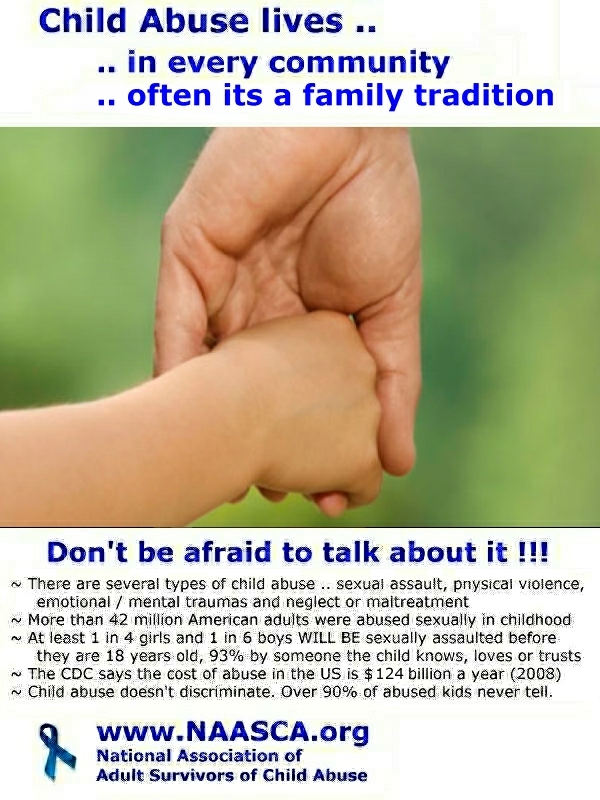 |
Child Abuse lives .. ...... in every community ...... often its a family tradition Sexual assault of children often includes incest. Incest is sexual contact between persons who are so closely related that their marriage is illegal (e.g., parents and children, uncles/aunts and nieces/nephews, etc.). This usually takes the form of an older family member sexually abusing a child or adolescent. There are very few reliable statistics about how often incest occurs. It's difficult to know how many people are affected by incest because many incest situations never get reported. There are many reasons that the victim might not report the abuse.
|
|
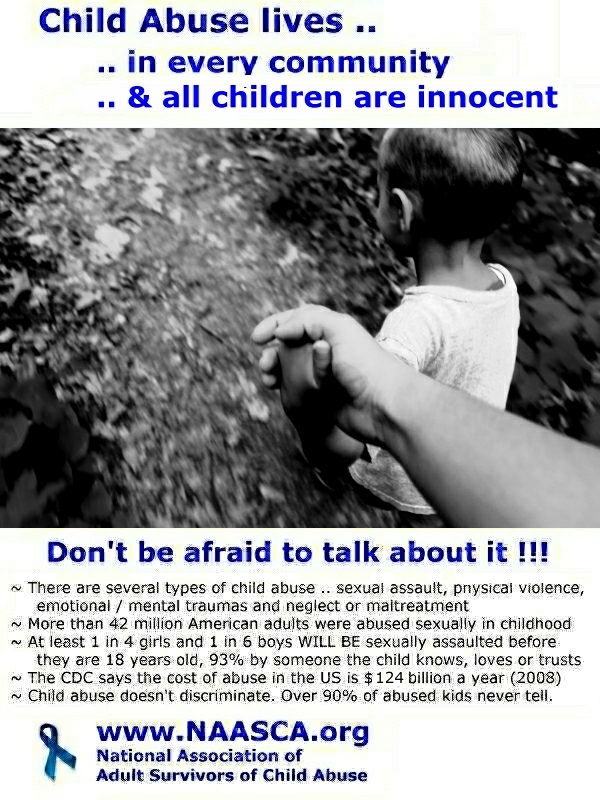 |
Child Abuse lives .. ...... in every community ...... & all children are innocent Child molestation usually begins with a sex offender gaining a child's trust and friendship. The offender then begins “testing” the child's ability to protect himself by telling sexual jokes, engaging in horseplay, back rubs, kissing or sexual games. If the child appears comfortable or curious about this type of behavior, (and most healthy, normal children are) the offender will slowly increase the amount and type of touching to include more direct sexual touching. Child sexual abuse can include exposing, fondling, masturbation, oral sex, intercourse and pornography. Many children do not understand that what is happening is sexual or wrong. Most offenders know that if they physically harm a child while molesting her, the child will be more likely to tell. They are also clever enough to make the child feel as if she is actually responsible for the contact. Children become trapped and are unable to tell anyone what is happening. Research has demonstrated that most of our school-based child abuse prevention programs do not prevent children from being abused and have little impact on reporting. The reason for the lack of impact on abuse is that children are not in a good position to protect themselves from adults, especially if the adult offender is a parent or caretaker. Given the way child molesters operate, it is imperative that adults, not children, become educated about child abuse, supervise their children more closely and take action if they suspect someone of abusing a child. Parents, schools, churches and community groups must also work together to develop prevention programs that incorporate parent training into prevention programs and encourage reporting. Please see: Protecting Your Children: Advice from Child Molesters |
|
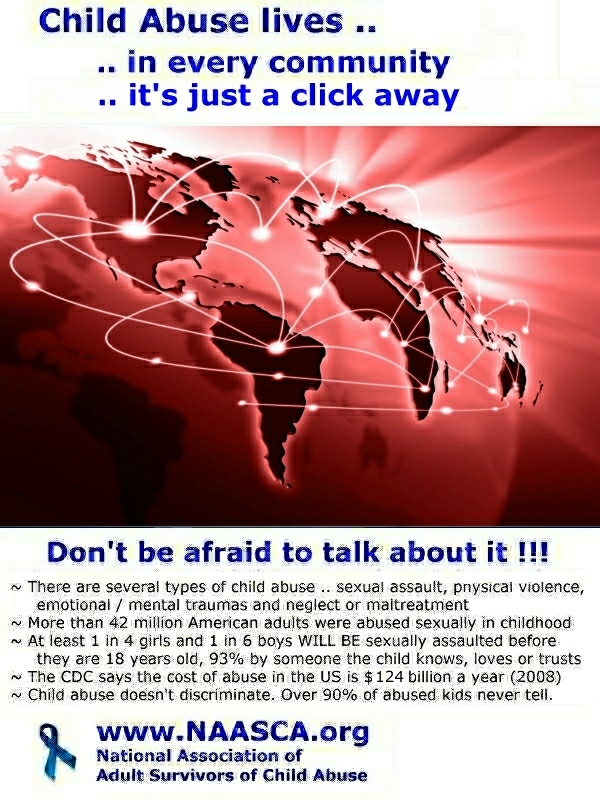 |
Child Abuse lives .. ...... in every community ...... it's just a click away In the offline world, communities are typically responsible for enforcing norms of privacy and general etiquette. In the online world, new etiquette challenges abound. In order to reap the benefits of socializing and making new friends, teens often disclose information about themselves that would typically be part of an acceptable “getting-to-know-you” process offline (name, school, personal interests, etc.). On social network sites, this kind of information is now posted online —sometimes in full public view. In some cases, this information is innocuous or fake. But in other cases, disclosure reaches a level that is troubling for parents and those concerned about the safety of online teens, and once children put this information online, they will never get it back. Teens are posting a tremendous amount of information on their online profiles, so it is vitally important that teens use strict privacy settings and are savvy about the individuals they allow to view their social networking profile. |
|
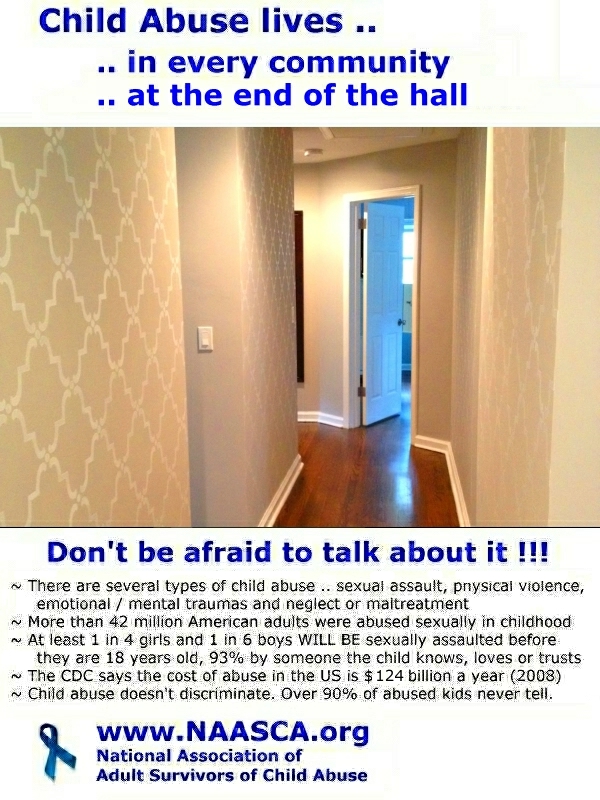 |
Child Abuse lives .. ...... in every community ...... at the end of the hall The concept of "stranger danger," the admonishment to avoid contact with anyone unknown to a youngster who's offering candy or a ride in their car, has been taught to children for decades, yet few speak of the mostly unavoidable predatory criminals who lurk right under a child's nose. Its only 7% of the time that a child will be assaulted by a total stranger. Studies show that 93% of the time a child will be sexually assaulted by someone that know, love or are supposed to be able to trust. An astonishing one third of these predators are immediate family members .. a father, mother, brother or sister .. and one third are extended family members .. mom's boyfriend, grandpa, a cousin or a very close family friend. The remaining third are commonly caregivers, often the very folks a parent turn a child over to .. teachers, babysitters, ministers, coaches, camp counselors, volunteers at boys and girls clubs .. the list goes on and on. The bottom line? Kids are FAR more likely to be assaulted by people in their own circle, and most often by a member of their own family. That's why prevention needs to be taught everywhere, not just at home but in schools, churches, clubs .. It's unrealistic to expect a six-year-old to fend off sexual advances from an adult relative. Children often cannot recognize sexual advances for what they are, and have been taught to “mind” adults who are authority figures. Adults are responsible for the safety of children. Adults are the ones who need to prevent, recognize and react responsibly to child sexual abuse. Please see: www.Darkness2Light.org |
|